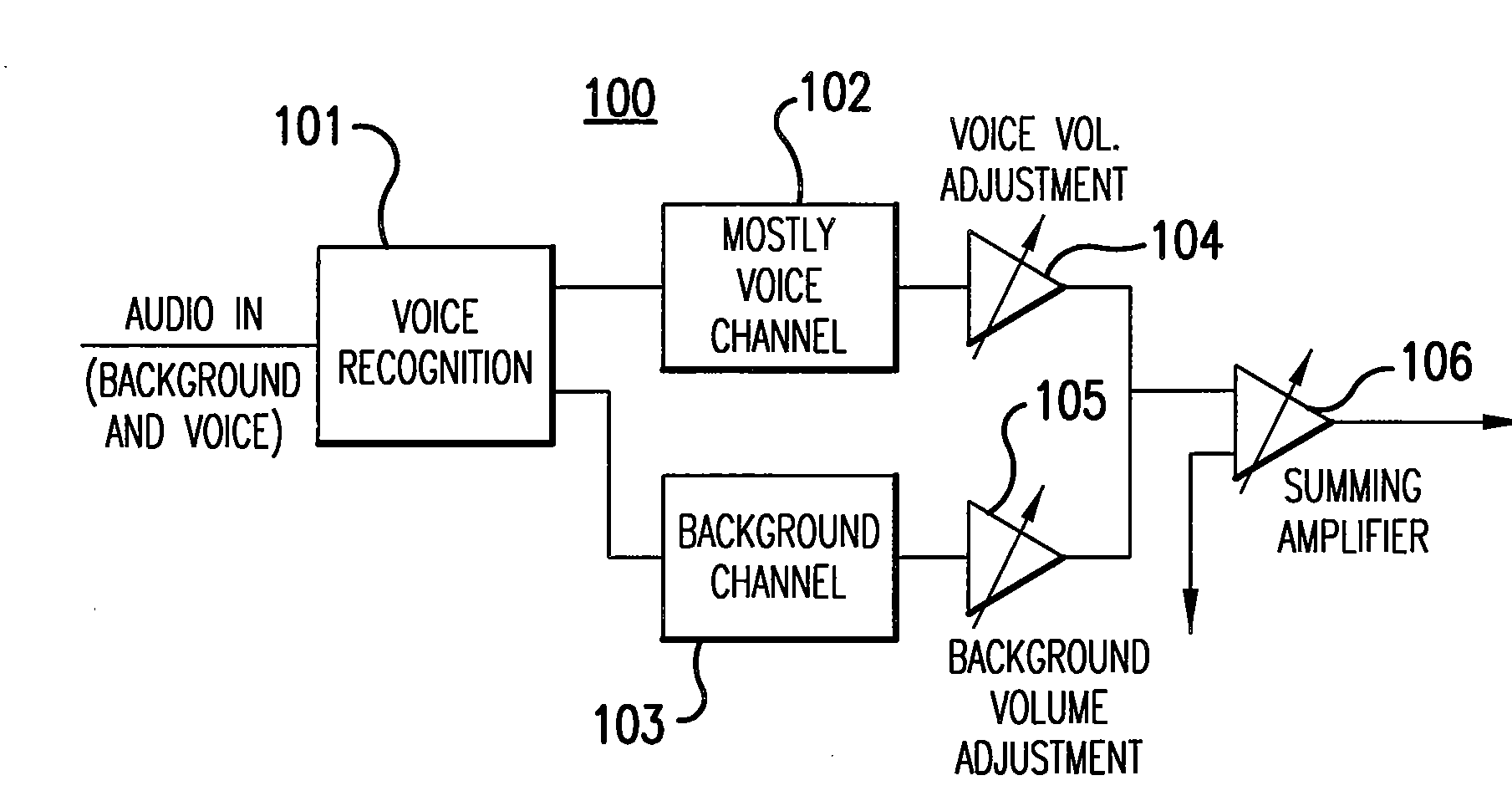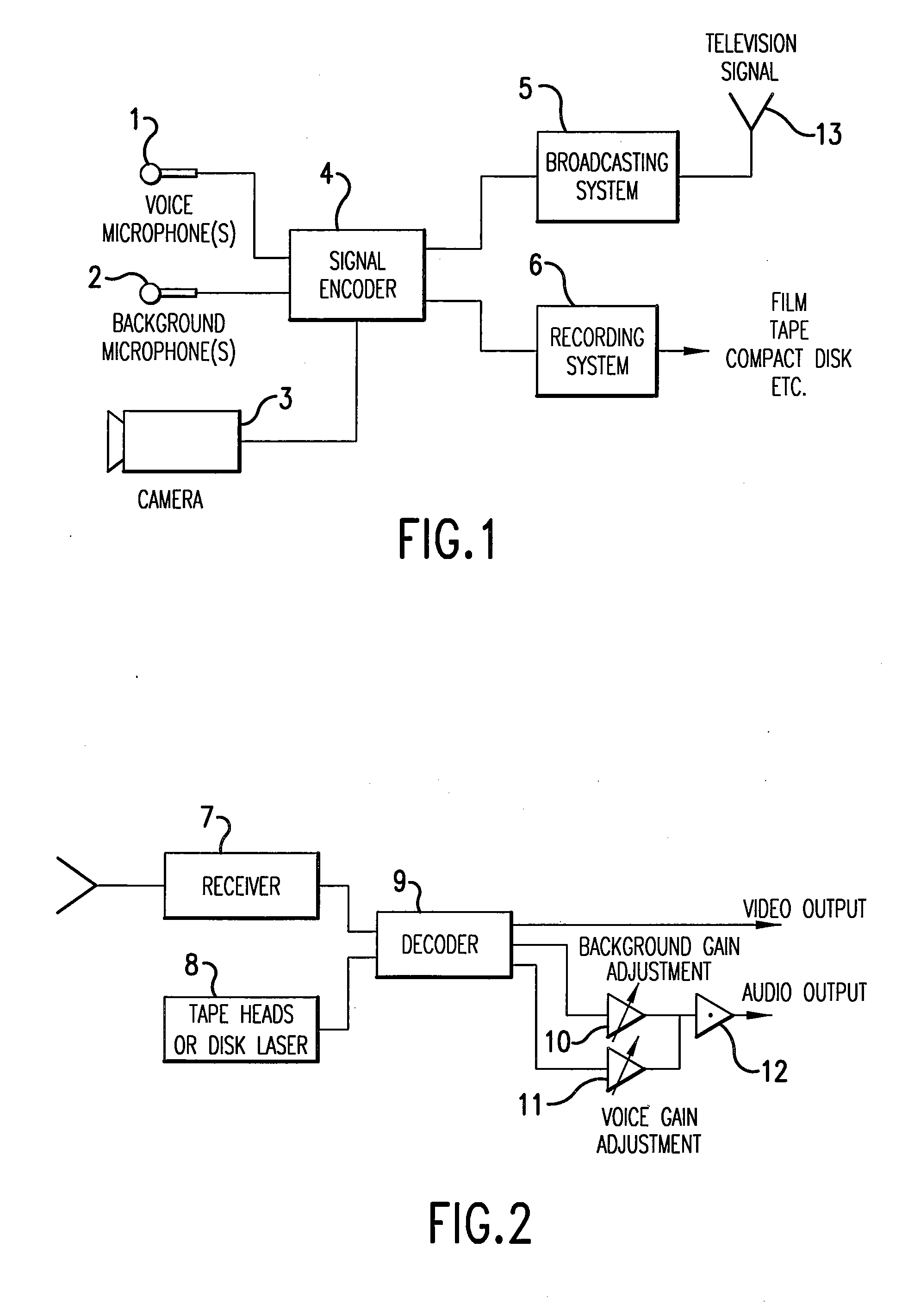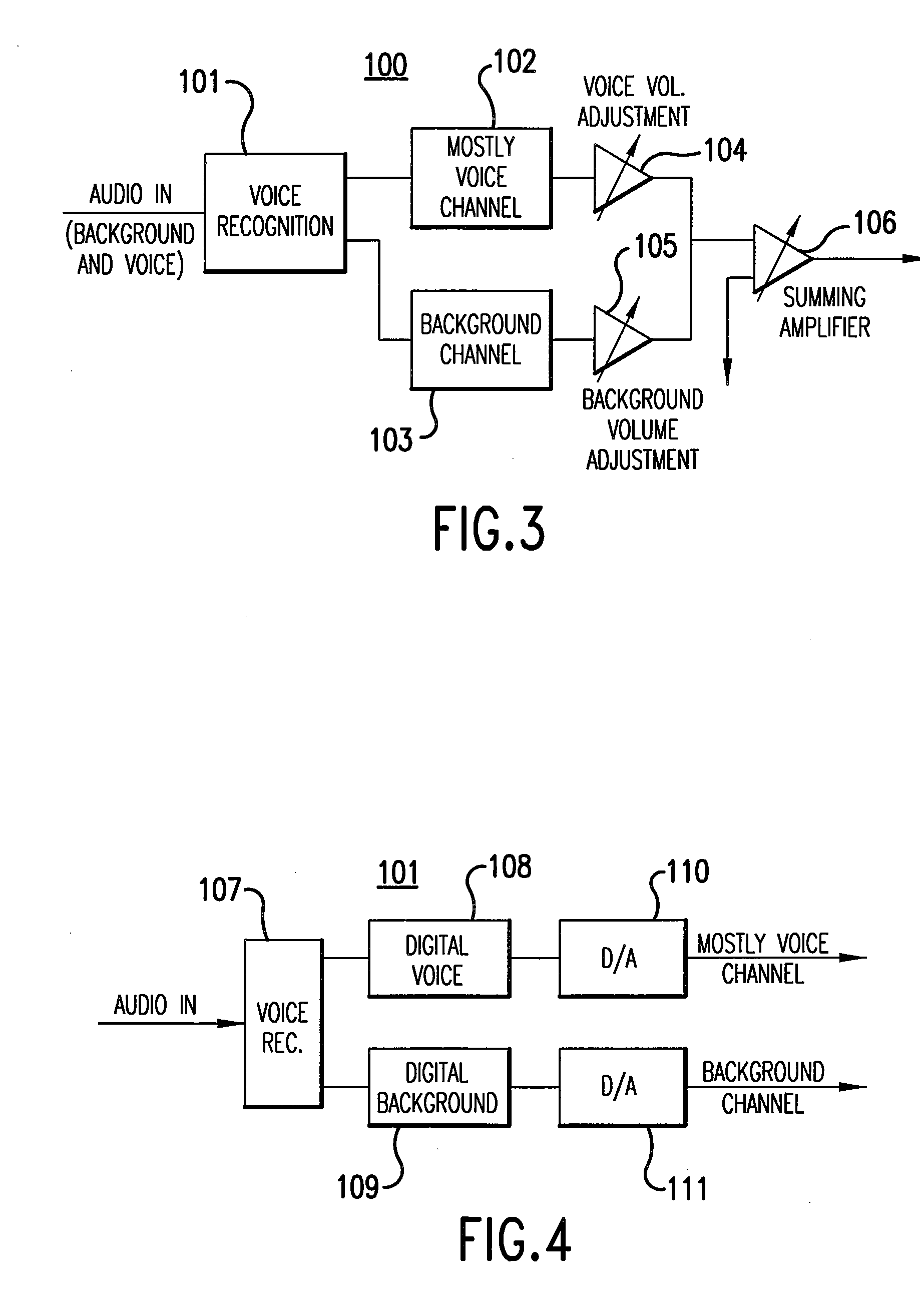There are also other segments of the total aural carrier that are not utilized or televisions are not currently equipped with the hardware to decode that segment of the bandwidth.
What this represents in terms of the preferred
signal transmission, is that there exists significant unutilized bandwidth in conventional television transmission standards that can accommodate additional signals transmitted in conjunction with the normal audio program.
This is not particularly desirable because it will make the transmission of stereo
programming impossible.
This cannot be accomplished however, without additional hardware that is not standard in current televisions or VCR's.
While adjusting the overall volume level of the preferred signal with respect to the volume level of the remaining audio will improve intelligibility and enjoyment for the
hearing impaired (as well as the normal hearing
population), it is not sufficient for many types of hearing impairment.
However, the
hearing impaired listener (who stands to benefit from this technology) may be somewhat disappointed in the apparent improvements.
If the hearing impairment of the listener resembles a
low pass filter (as many do) simply raising the
gain of the speech may not improve speech intelligibility because the low frequencies are now so loud that they are not enjoyable.
For large sizes the
delay between the amplitude factor 36 and the actual modified input signal may become quite large and cause the effects of the limiting to be delayed and in some cases not apparent.
However, smaller sizes of the vector may not provide an accurate representation for the total input signal, causing wide variations in the amplitude factor 36 and resulting in wide amplitude variations which may be unpleasant to listen to.
Selecting a maximum value of the vector will drastically lower the overall level of the input signal in the presence of very fast transient signals, and may lower the amplitude of other signals in the audio that need to be heard immediately following such a transient.
Selecting the RMS level of the vector may also not provide enough attenuation of the loud transients to make a perceivable difference.
If the preferred signal is multiplied by a very small number, the volume is greatly reduced thus defeating the purpose of the entire user adjustment operation.
It is recognized that this may not be desirable in programs that have very little or no remaining audio, such as news
programming.
This does not address the environment where the
end user is attempting to enjoy the
programming.
The reason this becomes a difficult prospect is because the audio programming itself contributes to the overall
ambient noise level in the listening environment.
This only represents an approximation of the ambient
noise signal and is limited by the accuracy of the
system identification.
Clearly this provides a more realistic performance but may be objectionable for those hard of hearing.
The average volume of the remaining audio frequently exceeds the average volume of the voice, making dialog difficult to understand.
Even though the VRA has been corrected during some segments of the program, other sections of the remaining audio are still too loud due to transients.
In addition, the dialog mode contains speech that is not pre-processed by the producer (which may be objectionable to those of normal hearing).
If the hearing impaired listener wants to hear the enhanced dialog in another language, it may not be possible unless yet another HI mode language is sent.
Moreover, the prior discussion has only focused on adjustments in terms of Dolby
digital audio.
Audiophiles with “high-end” equipment including multi-channel amplifiers and six-speaker systems, currently have a limited capability to adjust the volume on the center channel independently of the audio on the other five speakers.
It is a fact that a large majority of consumers do not and will not have a home theater that permits this adjustment capability, i.e., Dolby Digital decoder, six-channel
variable gain amplifier and multi-speaker
system for many years.
This greater
dynamic range causes most dialog to sound too low in the presence of some very loud sound effects.
User complaints that dialog levels have been recorded too low on DVD's are very common.
However, this fixed adjustment is only acceptable for certain audio passages and it disrupts the levels from the proper calibration.
Unfortunately this means that loud sounds are reproduced very loud (see dynamic range discussion above).
During late night viewing, this may not be desirable.
However, any adjustment of the speaker levels will disrupt the calibration.
As mentioned earlier these speaker levels may not be appropriate for nighttime viewing.
Many consumers do not have and will not have home theater systems for quite some time.
These
digital audio formats will require the
end user to have a 5.1
channel decoder in order to listen to any broadcast audio, however, they may not have the luxury of buying a fully adjustable and calibrated home theater
system with 5.1 audio channels.
The problem with the existing methods of downmixing is that they are transparent to and not controllable by the
end user.
This can present problems with intelligibility, given the manner in which dynamic range is utilized in the newer 5.1 channel audio mixes.
As an example, consider a movie that has been produced in 5.1 channels having a segment where the remaining audio masks the dialog making it difficult to understand.
Typically, downmixing of the
low frequency effects (LFE) channel is not done to prevent saturation of electronic components and reduced intelligibility.
This cannot improve dialog intelligibility because for any downmix situation, the center is mixed into the other channel containing remaining audio.
If the background audio is too loud, it will interfere with the end user's ability to discern speech components.
In its current embodiment, the existing
algorithm cannot accomplish either of these goals because explicit control is not established over the background audio (L and R), and the foreground audio cannot be raised with respect to the background audio.
This places limitations on what the signal content for each channel can be if the D / A has a fixed output range with no auto-scaling (addressed next).
It is inevitable that some spatiality ability be lost in this design because one of the 5 original audio channels must be occupied by pure foreground in order for the user to have control over the relative levels.
 Login to View More
Login to View More  Login to View More
Login to View More 


